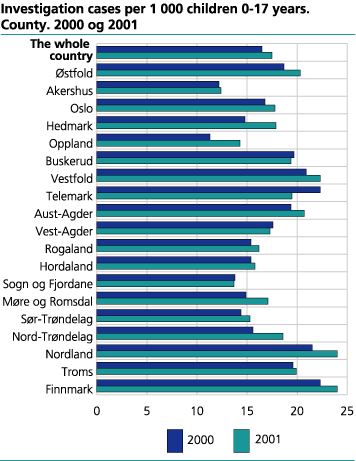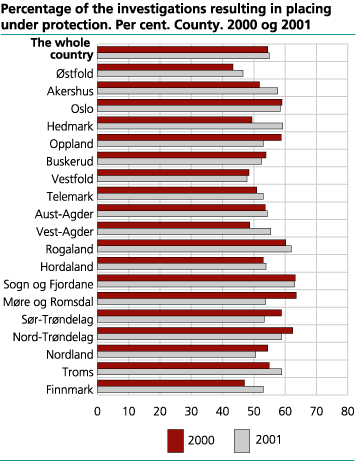Content
Published:
This is an archived release.
18 655 children were scrutinized
The child welfare service commenced a total of 18 655 investigations with respect to children in 2001. This is close to 1100 more cases than the year before.More than half of the investigations concluded in 2001 resulted in the child being put under protection.
18 investigations were commenced per 1 000 children aged 0-17 years in 2001, against 17 in 2000. Investigations were initiated more frequently vis-à-vis boys than girls. For the age group 14-17, the largest group, 22 investigations were commenced per 1 000 children in 2001. A total of 18 300 investigations were concluded in 2001. Of these 55 per cent resulted in intervention.
Big differences among counties
There are large differences among the counties with respect to how many investigations were commenced and the percentage that led to placing the child under protection. Finnmark and Nordland top the list with 24 investigations per 1 000 children under the age of 18, closely followed by Vestfold with 22 and Aust-Agder with 21. At the bottom of the list is Akershus with 12, and Sogn og Fjordane and Oppland both with 14 investigations per 1 000 children under 18.
Intervention in 55 per cent of the cases
Of all investigations, just over half, 55 per cent, led to intervention pursuant to the Child Welfare Service Act. Forty-four per cent were shelved without intervention. The conclusions of 1 per cent of the investigations are unknown. In top-ranking Sogn og Fjordane, nearly two out of three investigations (63 per cent) led to placing the child under protection. Rogaland also ranked near the top with respect to intervening following an investigation, with 62 per cent of the cases. In Hedmark, Troms og Nord-Trøndelag, 59 per cent of the investigations resulted in action being taken by the child welfare service, and in Oslo and Akershus the figure was 58 per cent.
On the other hand, in Østfold and Vestfold, less than half of the investigations led to intervention. Østfold ranked last, at 47 per cent.
The peers or social network of the child was ticked as the ones who reported the case in 34 per cent of the investigations commenced in 2001. The mother or father was by far the largest group in this category, accounting for 25 per cent of reports to the child welfare service in 2001. Neighbours, for example, accounted for 3 per cent of the reports leading to an investigation. Of the public bodies, school (11 per cent) and the child welfare service (11 per cent) were behind most reports of children in need of help. The police and emergency child protection centers accounted for 8 and 7 per cent respectively, while health stations and kindergartens were ticked as the reporting body in 5 and 3 per cent respectively of the investigations.
The statistics contain only data on who made the report about incidents leading to the investigations commenced in 2001. In other words, this represents not all reports to the child welfare service, but rather the reports in which the service found it necessary to initiate an investigation. Several persons or institutions may be behind one report.
Content of reports
In one in five cases (19 per cent) neglect or abuse was ticked as the reason for the report leading to an investigation, and similarly 20 per cent were triggered by the childs behavioural problems. Conditions in the home and special needs were ticked as the reason in just over half of the cases (54 per cent) while “other” was ticked in one in five cases (22 per cent).
Processing time takes more than half a year in 5 per cent of cases
Under the Child Welfare Services Act, the child welfare service is required to undertake all investigations without delay within three months. In special cases the deadline can be extended to six months.
Of the 18 300 investigations concluded in 2001, seven out of 10 (72 per cent) were concluded within the three-month deadline. A further forth (23 per cent) of the investigations were conducted and concluded within six months, and for five per cent the recorded processing time was more than half a year. Information is lacking for just under one per cent of the investigations. Average processing time in 2001 was 73 days, against 74 and 69 days in 2000 and 1999.
Tables:
The statistics is published with Child welfare.
Contact
-
Statistics Norway's Information Centre
E-mail: informasjon@ssb.no
tel.: (+47) 21 09 46 42


